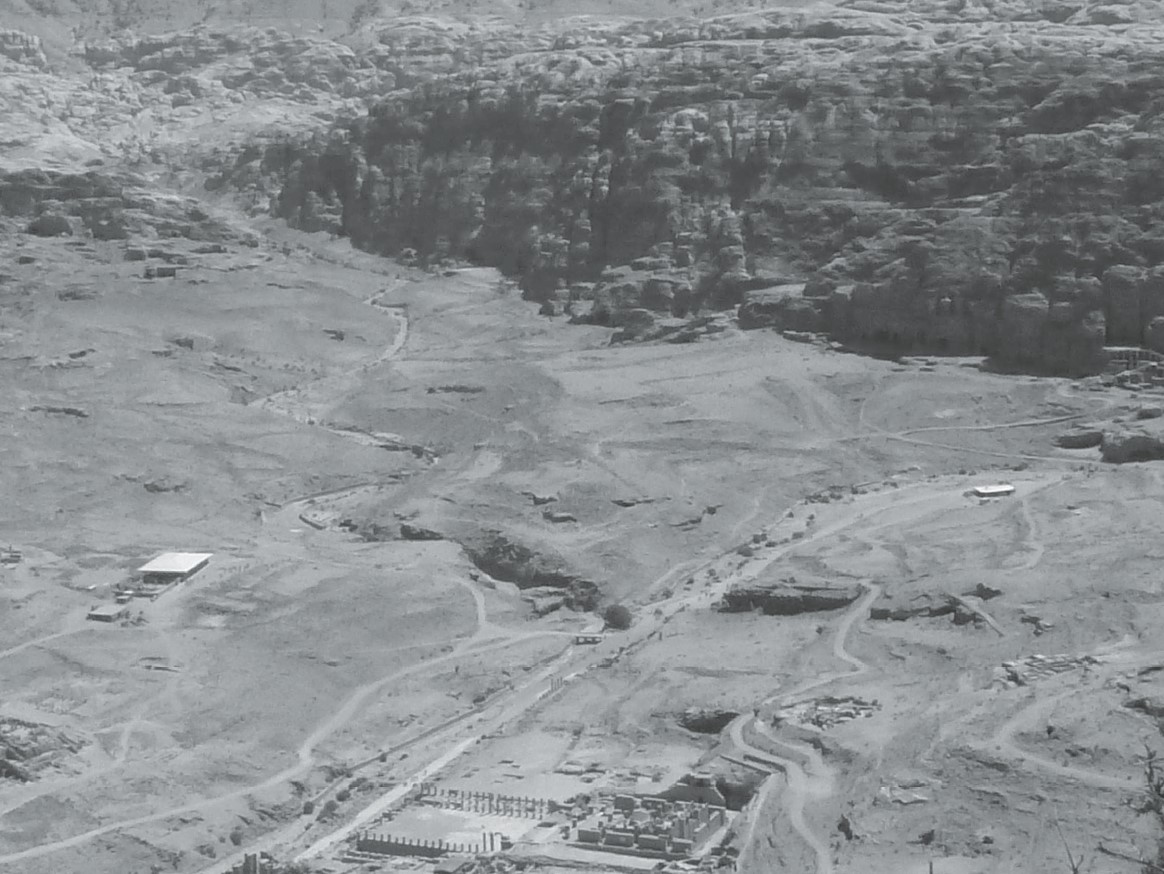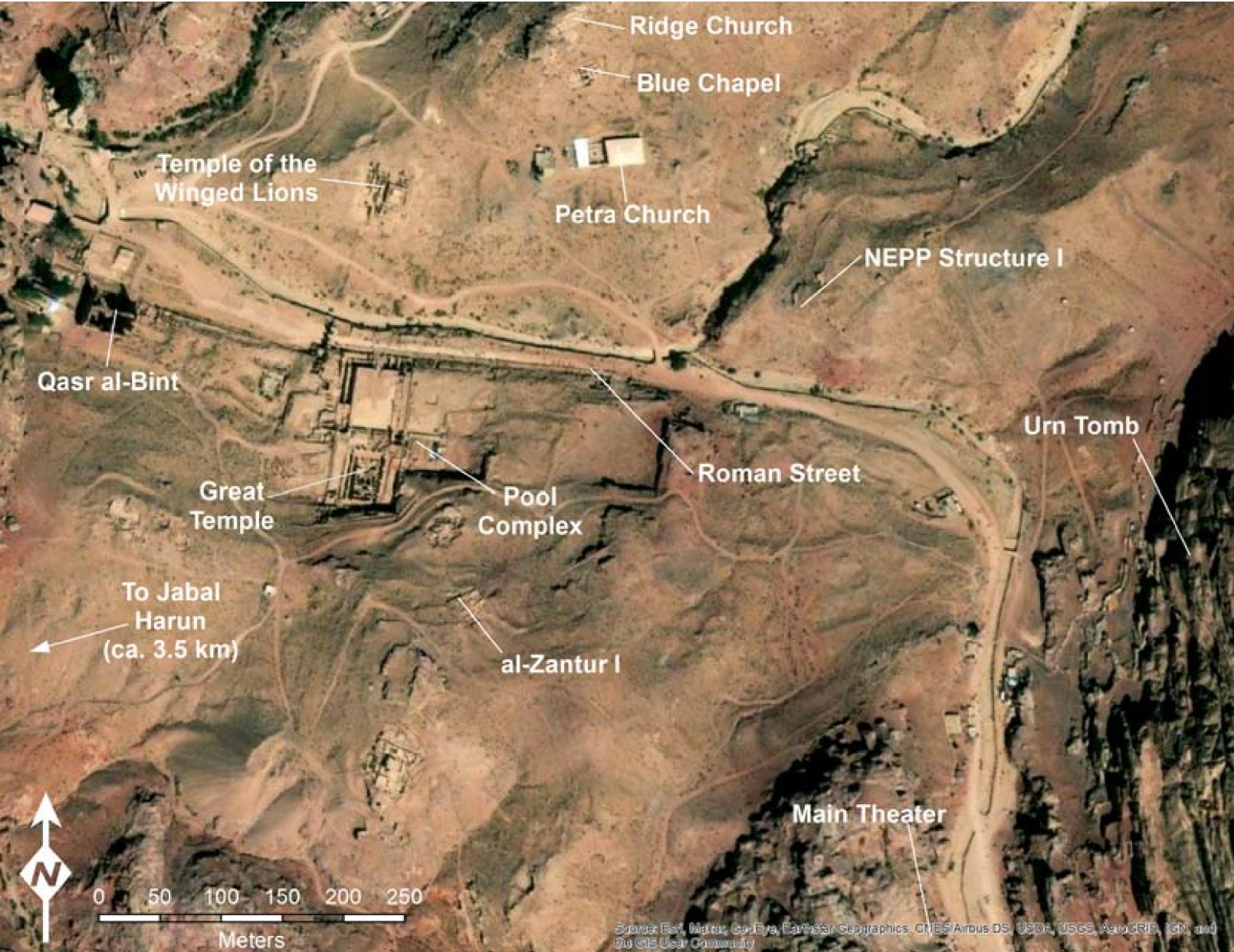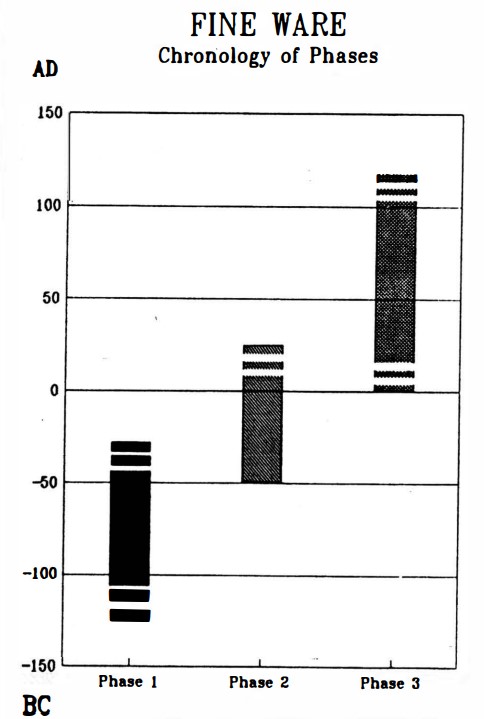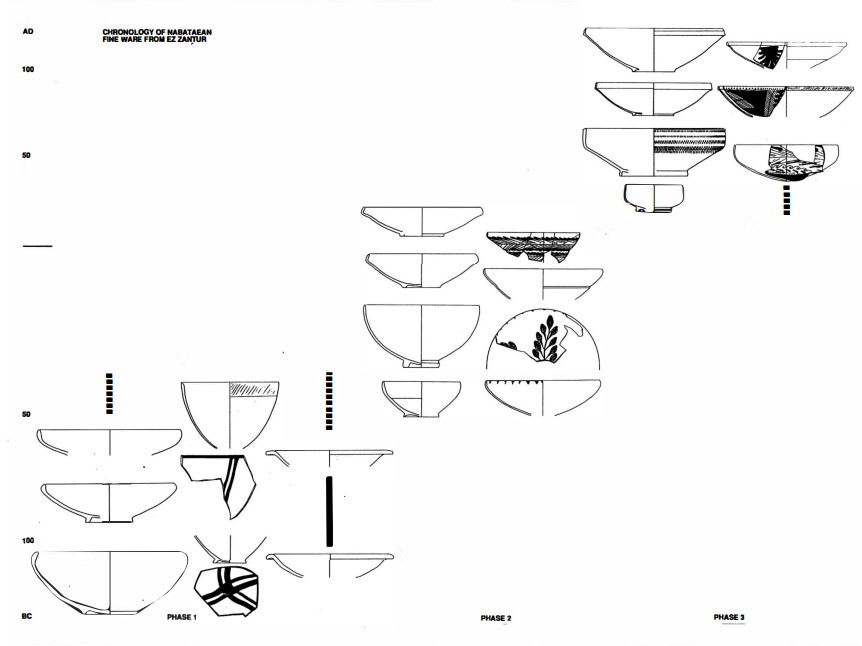Petra - NEPP Site
 Fig. 2
Fig. 2The NEPP area located between the Wadi Matahah (left), the Wadi Musa (right) and the face of the al-Khubthah massif.View from the West. Photo by S.G. Schmid
Fiema and Schmid (2014)
| Transliterated Name | Source | Name |
|---|---|---|
| NEPP site |
- from Chat GPT 5.2, 14 January 2026
- from Fiema and Schmid (2014)
On the basis of its peripheral position, monumental architecture, and direct integration with Petra’s hydraulic infrastructure, the NEPP area has been proposed as the location of the Nabataean basileia, the royal quarter in which the kings of Petra resided. Such an interpretation accords with Hellenistic models of royal space, in which royal residences were commonly set apart from the civic core, associated with administrative, cultic, and infrastructural installations, and designed to dominate the surrounding cityscape.
Archaeological evidence indicates that the principal occupation and architectural elaboration of the NEPP complex occurred during the 1st century CE. The area appears to have suffered major destruction in the 4th century CE, most plausibly during the earthquake of 19 May 363 CE, which caused widespread damage to monumental buildings across Petra. The apparent lack of sustained Byzantine reoccupation at the site, in contrast to other sectors of the city, suggests that seismic destruction played a significant role in the abandonment of this elite architectural zone.
- from Petra - Introduction - click link to open new tab
- Fig. 2 - Location Map from Jones (2021)

 Figure 2
Figure 2
Map of Petra with the locations of major excavations marked
Jones (2021)
Basemap: Esri, Maxar, Earthstar Geographics, USDA FSA, USGS, Aerogrid, IGN, IGP, and the GIS User Community - NEPP area in Google Earth
- Fig. 3 - Plan of the NEPP area
from Fiema and Schmid (2014)

 Figure 3
Figure 3
The plan of the NEPP area featuring Structures 1, 2, and 3. Plan by Jana Falkenberg and Maija Holappa
Fiema and Schmid (2014)
- Fig. 3 - Plan of the
NEPP area from Fiema and Schmid (2014)

 Figure 3
Figure 3
The plan of the NEPP area featuring Structures 1, 2, and 3. Plan by Jana Falkenberg and Maija Holappa
Fiema and Schmid (2014)
- Fig. 6 - Structure 1 interior
featuring a collapsed granite column from Fiema and Schmid (2014)
- Fig. 6 - Structure 1 interior
featuring a collapsed granite column from Fiema and Schmid (2014)
- from Schmid (1995)
- Ez-Zantur Excavations utilized Nabatean fineware chronology of Schmid (2000) - which I don't currently have access to
- This chronology appears to have been utilized for the NEPP site


Left
Chronology of Nabatean finewares
Right
Typology and chronology of the Nabataean fine ware
Both from Schmid (1995)
- Fig. 2 - Location Map from Jones (2021)

 Figure 2
Figure 2
Map of Petra with the locations of major excavations marked
Jones (2021)
Basemap: Esri, Maxar, Earthstar Geographics, USDA FSA, USGS, Aerogrid, IGN, IGP, and the GIS User Community - Fig. 3 - Plan of the NEPP area
from Fiema and Schmid (2014)

 Figure 3
Figure 3
The plan of the NEPP area featuring Structures 1, 2, and 3. Plan by Jana Falkenberg and Maija Holappa
Fiema and Schmid (2014)
- Fig. 2 - Location Map from Jones (2021)

 Figure 2
Figure 2
Map of Petra with the locations of major excavations marked
Jones (2021)
Basemap: Esri, Maxar, Earthstar Geographics, USDA FSA, USGS, Aerogrid, IGN, IGP, and the GIS User Community - Fig. 3 - Plan of the NEPP area
from Fiema and Schmid (2014)

 Figure 3
Figure 3
The plan of the NEPP area featuring Structures 1, 2, and 3. Plan by Jana Falkenberg and Maija Holappa
Fiema and Schmid (2014)
Fiema and Schmid (2014:429-430)
suggest that Structure 1 in the NEPP area was
destroyed by the 363 earthquake, but [was] later restored although in much altered form and appearance
with final
destruction and abandonment taking place afterwards, perhaps sometime in the early 5th century.
They suggest that final destruction and abandonment may have been
due to the Monaxius and Plinta Quake of 419 CE.
Jones (2021) argues that al-Zantur I Spatromisch II
ceramics, rather than dating from 363 CE - 419 CE, should date to at least a century later. If true, this would negate archaeoseismic
evidence for an earthquake reported in 419 CE
(i.e. the Monaxius and Plinta Quake)
at ez-Zantur and other sites in Petra such as in a structure outside the Urn Tomb,
and in Structure I of the NEPP Project.
Jones (2021) suggests instead that the
causitive earthquake was more likely the late 6th century CE
Inscription At Areopolis Quake.
Jones (2021) provides a
discussion below:
Within Petra, the 418/419 earthquake has been suggested as the cause for the destruction of three structures:NEPP Structure I has not been excavated, and the claim that it was destroyed in the 418/419 earthquake is based on surface finds and reference to al-Zantur I (Fiema and Schmid 2014: 431). Without excavation, the actual date and nature of the building's destruction remain uncertain. The claim for damage at Petra related to the 418/419 earthquake rests primarily, therefore, on the evidence from al-Zantur I.
- al-Zantur I, specifically the end of Bauphase Spatromisch II
- one of the structures outside of the Urn Tomb, House II
- North-Eastern Petra Project (NEPP) Structure I
| Effect | Location | Image(s) | Description |
|---|---|---|---|
|
Structure 1 |
|
| Effect | Location | Image(s) | Description |
|---|---|---|---|
|
Structure 1 |
|
-
Earthquake Archeological Effects chart
of Rodríguez-Pascua et al (2013: 221-224)

 Earthquake Archeological Effects (EAE)
Earthquake Archeological Effects (EAE)
Rodríguez-Pascua et al (2013: 221-224)
| Effect | Location | Image(s) | Description | Intensity |
|---|---|---|---|---|
|
Structure 1 |
|
|
-
Earthquake Archeological Effects chart
of Rodríguez-Pascua et al (2013: 221-224)

 Earthquake Archeological Effects (EAE)
Earthquake Archeological Effects (EAE)
Rodríguez-Pascua et al (2013: 221-224)
| Effect | Location | Image(s) | Description | Intensity |
|---|---|---|---|---|
|
Structure 1 |
|
|
Fiema, Zbigniew T., Schmid, Stephan G., and Kolb, Bernhard (2019) The Northeastern Petra Project: An Assessment
Fiema and Schmid 2014 Nabataean basileia and the earthquake of A.D. 363 in Petra: Some Considerations.
Jones, I. W. N. (2021). "The southern Levantine earthquake of 418/419 AD and the archaeology of Byzantine Petra." Levant: 1-15.


